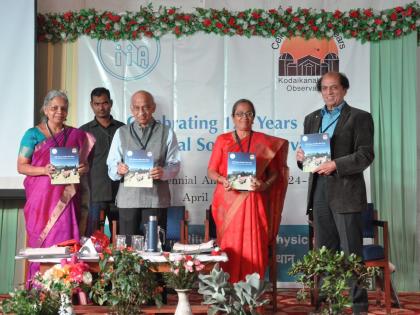Former Chairman of ISRO A.S. Kiran Kumar unveils the KSO 125 logo
By Anubha Jain | Published: April 8, 2024 07:05 PM2024-04-08T19:05:21+5:302024-04-08T19:06:24+5:30
The 125th anniversary of the iconic Kodaikanal Solar Observatory (KSO) housing historic and modern telescopes as well as a ...

Former Chairman of ISRO A.S. Kiran Kumar unveils the KSO 125 logo
The 125th anniversary of the iconic Kodaikanal Solar Observatory (KSO) housing historic and modern telescopes as well as a digital repository containing more than 1.2 lakh digitized and thousands of other solar images of the Sun recorded every day since the start of the 20th century, was celebrated on April 1st, 2024. Currently, KSO is operational as a field station under the Indian Institute of Astrophysics (IIA), which is an autonomous institution under the Department of Science and Technology (DST). A.S. Kiran Kumar, former Chairman of ISRO and Chairperson of the Governing Council of IIA unveiled the KSO 125 logo for the anniversary celebrations along with a booklet detailing the history and the research highlights of the Observatory. Senior and retired astronomers and engineers associated with the Kodaikanal Solar Observatory were felicitated on the stage. The 125th celebrations by IIA remembered the history of KSO.
Established on April 1st, 1899 by the British, the Observatory has been a cradle of research in solar astrophysics ever since, with several path-breaking discoveries to its credit. It has one of the longest continuous daily records of the Sun in the world, and this unique database has been digitized and is publicly available for astronomers from across the globe. April 1st is also celebrated by IIA as its Foundation Day, commemorating when it was constituted as an institution under the DST in 1971. The Foundation Day Lecture was delivered by A.S. Kiran Kumar from Kodaikanal on the “Indian Space Program”, where he sketched its history starting with the initial vision of Sarabhai.
Starting with these celebrations, IIA has planned several events over the coming months to highlight the Observatory’s rich history, its achievements, and ongoing research. The institute itself owes its origins to the Kodaikanal Solar Observatory (KSO), which in turn, arose from the Madras Observatory established in 1792. A.S. Kiran Kumar while speaking on the occasion said that curiosity about the Sun is as old as humanity itself, and remarked on the difficulties that the astronomers of a century ago must have faced in building such a globally renowned institution. He also pointed out the incredible 125 years of continuous solar observations and challenged astronomers to continue making discoveries with this dataset using modern tools. The Director of IIA, Prof. Annapurni Subramaniam, highlighted the legacy of the observatory and how more than a century of pursuit of knowledge required continuous innovation through multiple generations of technology while transferring skills through the generations of scientists as well.Prof. Siraj Hasan, former Director of IIA and a solar physicist; and S. Seetha, former Director of Space Science Program Office of ISRO also shared their views. The event brought into focus how the Kodaikanal Solar Observatory bears testament to more than a century and a half of scientists deciphering the Sun from Indian soil, starting with chasing eclipses, discovering Helium in 1868, to understanding the plasma process in the Sun and the production of prominences and flares.
Open in app